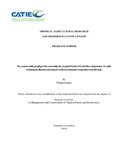Dry season cattle grazing in the seasonally dry tropical forests of Costa Rica: importance in cattle ranching livelihoods and impacts on forest botanical composition and diversity

Voir/
Date
2019Auteur
Godinot, Florent
Type
Tesis de maestría
Metadata
Afficher la notice complèteDescription
Tesis (Mag. Sc.) -- CATIE, 2019
Résumé
Central American seasonally dry tropical forests (SDTFs) are one of the most endangered ecosystems in the world, with little surface area under formal conservation status. Although there are no old-growth dry forests left in Costa Rica, secondary forests are growing back since the collapse of meat prices in the 1980s, but are subject to two major disturbances. The first is the frequent forest fires of anthropogenic origin. The second comes from a poorly documented ranching practice consisting of letting cattle enter the forest during the dry period to browse on the woody vegetation and benefit from the shade, and thus relieve the heat stress of the dry season. The frequency of this practice and its impact on ranching livelihoods are very little known and the impact of livestock on this ecosystem has been studied scarcely in the scientific literature. Forests on farms represent the majority of the tree cover of the Costa Rican SDTFs, and it is important to study them to determine if forests subject to fire and browsing are different from forests in protected areas, which are more extensively studied and less affected by those disturbances. This study focused on characterizing this practice and its impact on unprotected forests.
For this, 43 semi-structured interviews were conducted with farmers in the county of Liberia, Guanacaste, Costa Rica, to determine the importance of browsing in forests in ranching livelihoods. It was followed by an ecological sampling campaign in four unprotected forests on farms, which were compared with the protected forest of the Horizontes Forest Experimental Station (EEFH). Browsing in forest was identified as the most used supplementation during dry season, and it is considered critical in the management of farms, in a context of low profitability of ranching and climate change. This practice presented advantages for animal welfare, but complicated the efficiency of farm management. Such dilemma could be the factor that most impacts the farmer´s decision to take cattle to the forest, since statistical tests trying to relate browsing in forests with types of farms or supplementation profiles were inconclusive.
Sampling in forests found no differences between canopy strata in protected or unprotected forests. A cluster analysis found vegetation typologies distributed throughout the landscape, which depended partially on fires. The same analysis in undergrowth and soil vegetation strata found a stronger difference between conglomerates with plots in burned or browsed forests. A correlation test found a strong association between botanical compositions of the vertical strata in forests of the plots, but associations between clusters of different strata showed high variability. However, trends were found suggesting that fire or browsing may not be the most influential factors on forest composition and diversity of this landscape, although fire may have more impact than browsing. Since browsing in the forest is important for local livelihoods, agricultural institutions should not demonize this practice but rather work with farmers to develop good livestock practices or support this practice in a sustainable and controlled framework. More detailed research is required to confirm the preliminary findings of this study.
Keywords
Éditeur
CATIE, Turrialba (Costa Rica)
Collections
- Tesis [1392]

